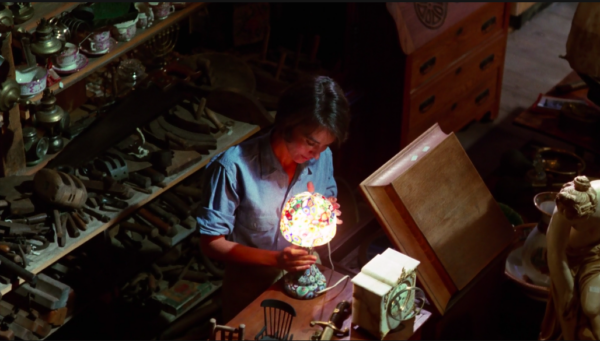What we used to call art begins at a distance of two meters from the body,” writes Walter Benjamin in “Dream Kitsch.” “But now, in kitsch, the world of things advances on the human being; it yields to his uncertain grasp and ultimately fashions its figures in his interior.”
A weird amalgam of a translation error, a kitsch object, and poetry itself haunts Let’s Scare Jessica To Death, John Hancock’s eerie 1971 directorial debut. This unnerving amalgam calls itself “malfiori.” It’s a seemingly innocuous object whose occult influence blooms on the surface of the film, a kernel of poetic kitsch burning at the bottom of the narrative.
In the film, Jessica, recently released from treatment at a psychiatric hospital, moves to a remote farmhouse with her husband, Duncan, and their friend, Woody. Duncan and Jessica scavenge some items from the house to sell at The Black Whale, an antique shop. As we enter the scene, the signatures of kitsch proliferate: Greek statuettes, an ornate gold cherub clock, rocaille ceramicware, things under bell jars. Jessica drifts through the shop, then her attention is arrested by a prismatic lamp. The high-angle shot gives us the sensation of peering into a snow globe, Jessica’s private dreamworld. She falls under its spell. Sam Dorker, the antiques dealer, notices:
Dorker: “Oh, you like that? I was just about to show you that. That’s a malfiori lamp. Do you understand Italian? Malfiori, that means ‘flowers of evil.’ Or ‘evil flowers.’ They’re painted right on there.”
Jessica: “Flowers of evil. How can anything this pretty be evil? It’s just old, that’s all.”

Let’s Scare Jessica To Death (1971) Directed by John Hancock
Millefiori, a thousand flowers. Malfiori, flowers of evil. And suddenly we’re in the realm of poetry, Dorker’s mistranslation warping the kitschy lamp into an allusion to the poet who prowled the arcades in Paris where mass-produced souvenirs entered the lexicon of modern life.
In The Artificial Kingdom: A Treasury of the Kitsch Experience, Celeste Olalquiaga describes the nineteenth-century trend of collecting paperweights, objects that Ludwig II called “dream spheres”:
“Representing in the paradoxical transience of their ‘eternal’ beauty both the intensity and the frailty of human emotions, encased flowers’ apparent entrapment of a vanishing reality peaked in the mid-1800s popularization of glass globes where glass flowers and flowery effects made with glass canes (known as millefiori, ‘thousand flowers’), as well as cameos and vistas, were ethereally suspended like so many memories.”
Johannes writes of another kind of flowery “mistranslation” in Poetry Against All: “The word ‘tusenskönor’: The correct translation is ‘daisies.’ Daisies. Ann Jäderlund would never write a poem with ‘daisies’ in it. Her poems are teeming with thousandbeauties.” Also relevant is Johannes’ expansion on Daniel Tiffany’s analysis of Wordsworth’s Lyrical Ballads preface in Transgressive Circulation:
“Anti-kitsch rhetoric is thus not just intertwined with poetic diction, but also with translation and foreign literature: foreign literature leads to the contamination of the language ‘really used by men.’ Perhaps the problem is that language influenced by translation is poetic, worthless, non-utilitarian—as in Bataille’s ‘general economy’—because it is foreign, tainted, ineffective.”
Olalquiaga points out that millefiori paperweights also originally occupied a “non-utilitarian” space beyond the official sanction of commodity production: “Made in the workers’ sparse free time and with the leftovers of the official glass production, ‘frigger’ or ‘offhand’ weights were often inscribed with female names or the word ‘souvenir,’ which soon came to generically dominate them.” It seems likely that this defiant sense of uselessness is behind most of the cultural antipathy toward both poetry and kitsch.
The source of terror in Let’s Scare Jessica To Death is Jessica’s sense that she can’t distinguish between dream and reality. Or maybe between poetry and life. Fear of poetry, fear of kitsch—the anxiety that things are not as they seem or that they are exactly what they seem. And the film places translation at the intersection of these twin anxieties.
In the final scene, having escaped the carnage at the farmhouse, Jessica drifts in a rowboat on the silvered surface of a lake. The atmospheric haze from the water, the wistful piano phrases, and the faded 1971 color transfer create a postcard effect, her ordeal crystallized (to use Olalquiaga’s term) into a souvenir. She speaks in voiceover:
“I sit here and I can’t believe that it happened. And yet I have to believe it. Nightmares, dreams, madness or sanity. I don’t know which is which.”
Zack Anderson holds an MFA from the University of Notre Dame. His book reviews appear in American Microreviews & Interviews, Harvard Review, and Kenyon Review. His poems have recently been published in Fairy Tale Review, The Equalizer, White Stag, and others. He currently lives in Athens, Georgia where he is a PhD student at the University of Georgia. @ZackAanderson